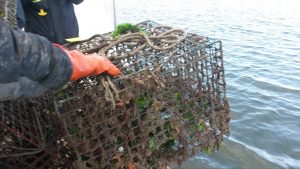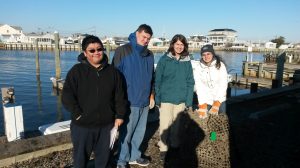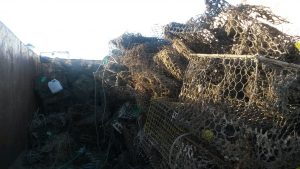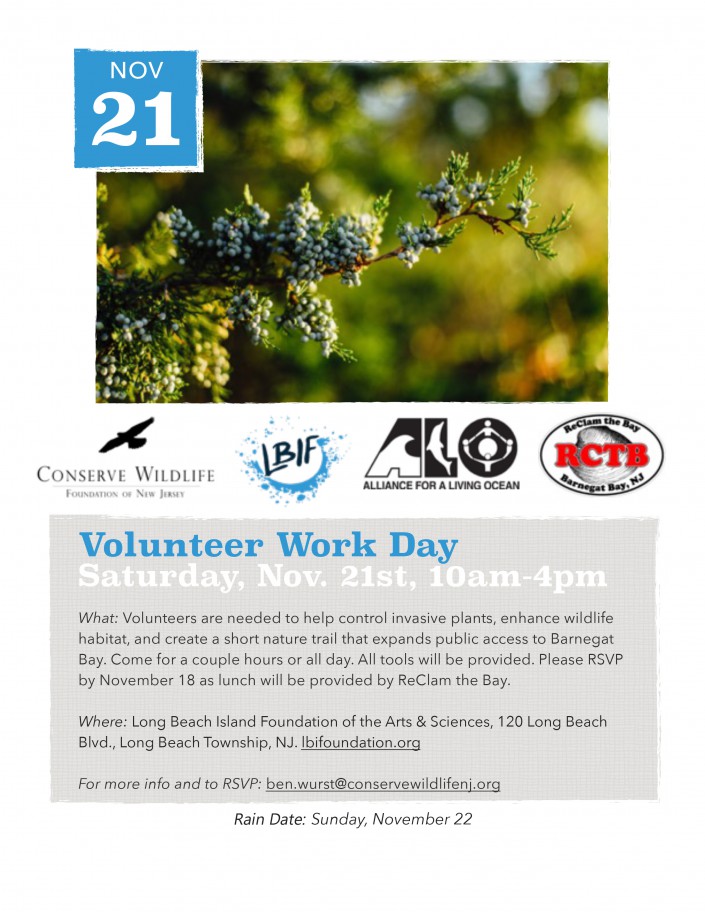Ghost Fishing
How CWF Is Fighting This Threat to Wildlife in Barnegat Bay
by Emily Heiser, Wildlife Biologist
For many coastal communities in New Jersey, like the Barnegat Bay region, winter is a time for rejuvenation and the preparation of our resources for a busy summer season. It only makes sense that we also start to prepare the coast’s most precious resource – the bay.
Barnegat Bay is approximately 42 miles of brackish marsh and bay bordering Ocean County. The bay and surrounding marshlands are rich in vital resources that directly and indirectly support over 60,000 jobs and have an economic value of $2 to $4 billion dollars annually (Barnegat Bay Partnership Economic Report 2012).

Part of that economic value is attributed to the tremendous blue claw crab fishery in the bay. The New Jersey Division of Fish and Wildlife estimates that commercial and recreational crabbers harvest around 6 million crabs per year from New Jersey waters. Barnegat Bay, along with Little Egg Harbor and the Maurice River estuary comprise approximately 65-86% of the recreational harvest that occurs annually. Recreational crabbers use a variety of methods, but typically rely on baited pots or hand lines for crabbing. Regulations exist for the use of pots, but their unintentional loss has created an economic and environmental problem for all portions of Barnegat Bay.
CWF, along with our partners, has been diligently organizing and executing what is essentially a cleanup of these pots within Barnegat Bay. In 2015 and 2017, CWF was granted a NOAA Marine Debris Removal Program grant to support the removal of derelict crab pots, also know as ghost pots, from Barnegat Bay. Over the course of the last three years, we have removed over 1,300 crab pots that have become a death trap for a variety of marine organisms, including diamondback terrapins and otherwise fishable blue crabs.

All of the fieldwork on this project occurs during the chilling winter months when only the hardiest of fishermen can be found on the water. The blue crab season is open in most parts of the state from March 15th – November 30th leaving the coldest months to head out and collect pots that are not supposed to be actively fishing. Several partners have made this project a possibility – the Marine Academy of Technology and Environmental Science, Stockton University, Monmouth University, ReClam the Bay, American Littoral Society, and through contracts with local fishermen.
Using side-scan sonar units, crews head out in early December to start looking for ghost pots. Once a sufficient number of pots have been marked, waypoints are transferred over to retrieval crews. Retrieving the pots sounds easy in theory, but can be time-consuming and success is dependent on many compounding factors such as substrate, weather, and tidal conditions. Upon relocation of a surveyed pot, the captain must line the boat up to the best of their ability and with as much accuracy as they can, instructs the crew where to throw the grapple line. Often you hear them call out, “Five feet – left center” and amazingly, the crew throws the grapple and hooks into a pot! Depending on the substrate and how long the pot has been on the bay floor, it can be very difficult and dangerous to leverage out. With the use of just the right amount of engine power, sunken pots can be delicately coaxed out of the water and lifted onto the boat by crews. Once a pot is on the boat, a rapid assessment is done to look for unintended bycatch, pot design, and encrusting organisms. Some of the various bycatch that has been found in pots include several species of crabs, lobster, flounder, tautog, and sadly, several diamondback terrapins. One pot contained the remains of more than 17 diamondback terrapins.

After a day of retrievals, the crew heads back to the marina where pots are placed in a disposal bin. The bins are provided to the project through the successful Fishing for Energy Program run by National Fish and Wildlife Foundation, Covanta Energy, and Schnitzer Steel. Gear collected from our port is stripped for recyclable materials at Schnitzer Steel and then non-recyclable material is turned into energy at Covanta’s facility in Rahway, New Jersey. The holistic nature of this project breathes life into the term, “reduce, reuse, recycle”.
Barnegat Bay’s ghost pots exemplify an overarching issue of our environment, human-wildlife conflicts. The Bay’s vital resources drive the economy and addressing these issues make us better stewards of the Bay and its resources.
